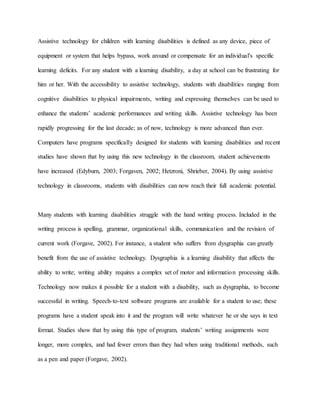
AssistiveTechnologyFINALDRAFT
- 1. Assistive technology for children with learning disabilities is defined as any device, piece of equipment or system that helps bypass, work around or compensate for an individual's specific learning deficits. For any student with a learning disability, a day at school can be frustrating for him or her. With the accessibility to assistive technology, students with disabilities ranging from cognitive disabilities to physical impairments, writing and expressing themselves can be used to enhance the students’ academic performances and writing skills. Assistive technology has been rapidly progressing for the last decade; as of now, technology is more advanced than ever. Computers have programs specifically designed for students with learning disabilities and recent studies have shown that by using this new technology in the classroom, student achievements have increased (Edyburn, 2003; Forgaven, 2002; Hetzroni, Shrieber, 2004). By using assistive technology in classrooms, students with disabilities can now reach their full academic potential. Many students with learning disabilities struggle with the hand writing process. Included in the writing process is spelling, grammar, organizational skills, communication and the revision of current work (Forgave, 2002). For instance, a student who suffers from dysgraphia can greatly benefit from the use of assistive technology. Dysgraphia is a learning disability that affects the ability to write; writing ability requires a complex set of motor and information processing skills. Technology now makes it possible for a student with a disability, such as dysgraphia, to become successful in writing. Speech-to-text software programs are available for a student to use; these programs have a student speak into it and the program will write whatever he or she says in text format. Studies show that by using this type of program, students’ writing assignments were longer, more complex, and had fewer errors than they had when using traditional methods, such as a pen and paper (Forgave, 2002).
- 2. Students that have writing disabilities, such as dysgraphia and dyslexia, can also greatly benefit from using a word processor as assistive technology in the classroom. Studies suggest that “[t]he ability to produce a product that can be edited, spell-checked, read, and presented to the teacher can increase motivation and encourage writing, because specific problems with handwriting and spelling can be circumvented” (Hetzroni, Shrieber, 2004). With current technology advances, students now have portable word processors with them; this makes the transition to school easy and the accessibility to take the word processor anywhere that student needs it to be. Research has already told us that these technologies not only make a child’s school life less stressful, but it also helps the child to become more successful in the classroom. Dyslexia is another type of disability in which a student can benefit from AT. Dyslexia is language processing disorder can hinder reading, writing, spelling, and sometimes even speaking. Much of what happens in the classroom is based on reading and writing, so a student with dyslexia can have many struggles every day in the classroom. Currently, there are many devices available to help with the success of a student and can be effectively placed in an IEP and general education class. One example is a portable scanner pen. These are portable devices which dyslexic people can use to listen to text instead of reading it. The user points the scanning pen on a particular printed word and the pen’s speech synthesizer then speaks that word. Scanning pens can also scan a line of text and read it aloud. Some of these devices have built-in dictionaries that can speak the definition of a scanned word. As well as the portable word processor, a student can take this device to assist with homework assignments, as well as anywhere else in everyday life. Another simple type of AT device is an audio book. Dyslexic
- 3. students often have a difficult time reading, and most portable devices like an IPod or an Ipad come equipped to be able to download an app in minutes. With the use of headphones, a student can learn a lesson during class time without any interruptions for the other students. In summary, assistive technologies are the devices provided to students that have a learning disability. These students that have a disability depend on these devices so that they can be successful in the classroom, and it has been proven by studies that this is a fact. Students with learning disabilities, such as dysgraphia, benefit from technologies and software such as a text- to-speech program or a word processor. These word processors help students with grammatical error as well as organizational skills. With current software and updates on technology, students are able to have accessibility to technology whenever it is needed.
- 4. References Edyburn, D. (2003). Researd and Practice. Journal of Special Education and Technology, 18(2), 61-64. Forgave, K. (2002 Assistive technology: Empowering students with learning disabilities. The Clearing House, 75(3), 122-126. Hetzroni, O.E., Shrieber, B. (2004). Word processing as an assistive technology tool for enhancing academic outcomes of students with writing disabilities in the classroom. Journal of Learning Disabilities, 37(2), 143-154.